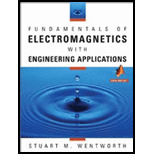
Concept explainers
You are given two z–directed line charges of charge density
Want to see the full answer?
Check out a sample textbook solution
Chapter 2 Solutions
Fundamentals of Electromagnetics with Engineering Applications
- Matched filter in the frequency domain (1.5) (a) Consider the signal s(t) in 3(c). Assuming that the unit of time is a millisecond and the desired frequency resolution is 1 Hz, use the function contFT to compute and plot |S(f). (b) Use the function contFT to compute and plot the magnitude of the Fourier trans- form of the convolution s * SMF numerically computed in 3(d). Also plot for comparison |S(f)12, using the output of 5(a). The two plots should match. (c) Plot the phase of the Fourier transform of s✶ SMF obtained in 5(b). Comment on whether the plot matches your expectations.arrow_forwardFind Eigenvalues and Eigenvectors for the following matrices: [10 4 A=0 2 0 3 1 1 -3arrow_forward1. (20 pts) Plot the pulse and the FFT for a pulse with the following properties at x=0 and x=10 cm. f=2 MHz m=3 Ncyc=2, 6, 20 po 1 MPa (source pressure) x=10 cm (propagates in a Newtonian fluid for 10 cm as a plane wave-not a sound beam) a=0.5 dB/(MHz cm) Consider 3 types of waves: sine, square, and sawtooth. (square and sawtooth only for grad students) Observe your plots and draw some conclusions. Discuss any possible issues you encounter. 2. (20 pts) We have the following 3 ultrasonic transducers: a. Focused 1 MHz, 2.54 cm diameter, 5.08 cm focus b. Focused 3 MHz, 2.54 cm diameter, 5.08 cm focus c. Unfocused 0.1 MHz, 2.54 cm diameter The transducers are operating in water (c=1486 m/s). I. Plot the axial field for all transducers II. Plot the focal transverse field for the focused transducers and the transverse field at the Rayleigh distance (R_0) and at 2R_0 for the unfocused. III. Assume source pressure of 0.1 MPa, and find the acoustic pressure in MPa at the location (r=0, z=4.5…arrow_forward
- Find the Q-points for the diodes in the circuit. Assume ideal diodes, and startwith the assumption that D is OFF, and D2 is ON for both circuits.arrow_forwardplease see the following image to answer questions thanksarrow_forward5- Find the Eigenvalues and the corresponding Eigenvectors. [4 5 31 A=0 4 6 Lo 0 1arrow_forward
- Find the Eigenvalues and the corresponding Eigenvectors. 4 2 -2 A = 2 5 0,2=4 -2 -2 0 3arrow_forward1. Label the x, y, z coordinates for each frame. 2. Compute the homogeneous transformation matrices H between frames 0, 1, 2, and end- effector.arrow_forwardFind Eigenvalues and Eigenvectors for the following matrices: 1] [5-6 A = 1 1 0 L3 0 1arrow_forward
- Use Gauss-Jordan Elimination method to solve the following system: 4x1+5x2 + x3 = 2 x1-2x2 3x3 = 7 - 3x1 x2 2x3 = 1. -arrow_forwardFind the Eigenvalues and the corresponding Eigenvectors. A = [³/2 9] 3.arrow_forwardFind the Q-points for the diodes in the circuit. Assume ideal diodes, and startwith the assumption that both diodes are ON for both circuits.arrow_forward
 Introductory Circuit Analysis (13th Edition)Electrical EngineeringISBN:9780133923605Author:Robert L. BoylestadPublisher:PEARSON
Introductory Circuit Analysis (13th Edition)Electrical EngineeringISBN:9780133923605Author:Robert L. BoylestadPublisher:PEARSON Delmar's Standard Textbook Of ElectricityElectrical EngineeringISBN:9781337900348Author:Stephen L. HermanPublisher:Cengage Learning
Delmar's Standard Textbook Of ElectricityElectrical EngineeringISBN:9781337900348Author:Stephen L. HermanPublisher:Cengage Learning Programmable Logic ControllersElectrical EngineeringISBN:9780073373843Author:Frank D. PetruzellaPublisher:McGraw-Hill Education
Programmable Logic ControllersElectrical EngineeringISBN:9780073373843Author:Frank D. PetruzellaPublisher:McGraw-Hill Education Fundamentals of Electric CircuitsElectrical EngineeringISBN:9780078028229Author:Charles K Alexander, Matthew SadikuPublisher:McGraw-Hill Education
Fundamentals of Electric CircuitsElectrical EngineeringISBN:9780078028229Author:Charles K Alexander, Matthew SadikuPublisher:McGraw-Hill Education Electric Circuits. (11th Edition)Electrical EngineeringISBN:9780134746968Author:James W. Nilsson, Susan RiedelPublisher:PEARSON
Electric Circuits. (11th Edition)Electrical EngineeringISBN:9780134746968Author:James W. Nilsson, Susan RiedelPublisher:PEARSON Engineering ElectromagneticsElectrical EngineeringISBN:9780078028151Author:Hayt, William H. (william Hart), Jr, BUCK, John A.Publisher:Mcgraw-hill Education,
Engineering ElectromagneticsElectrical EngineeringISBN:9780078028151Author:Hayt, William H. (william Hart), Jr, BUCK, John A.Publisher:Mcgraw-hill Education,





